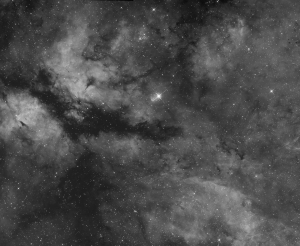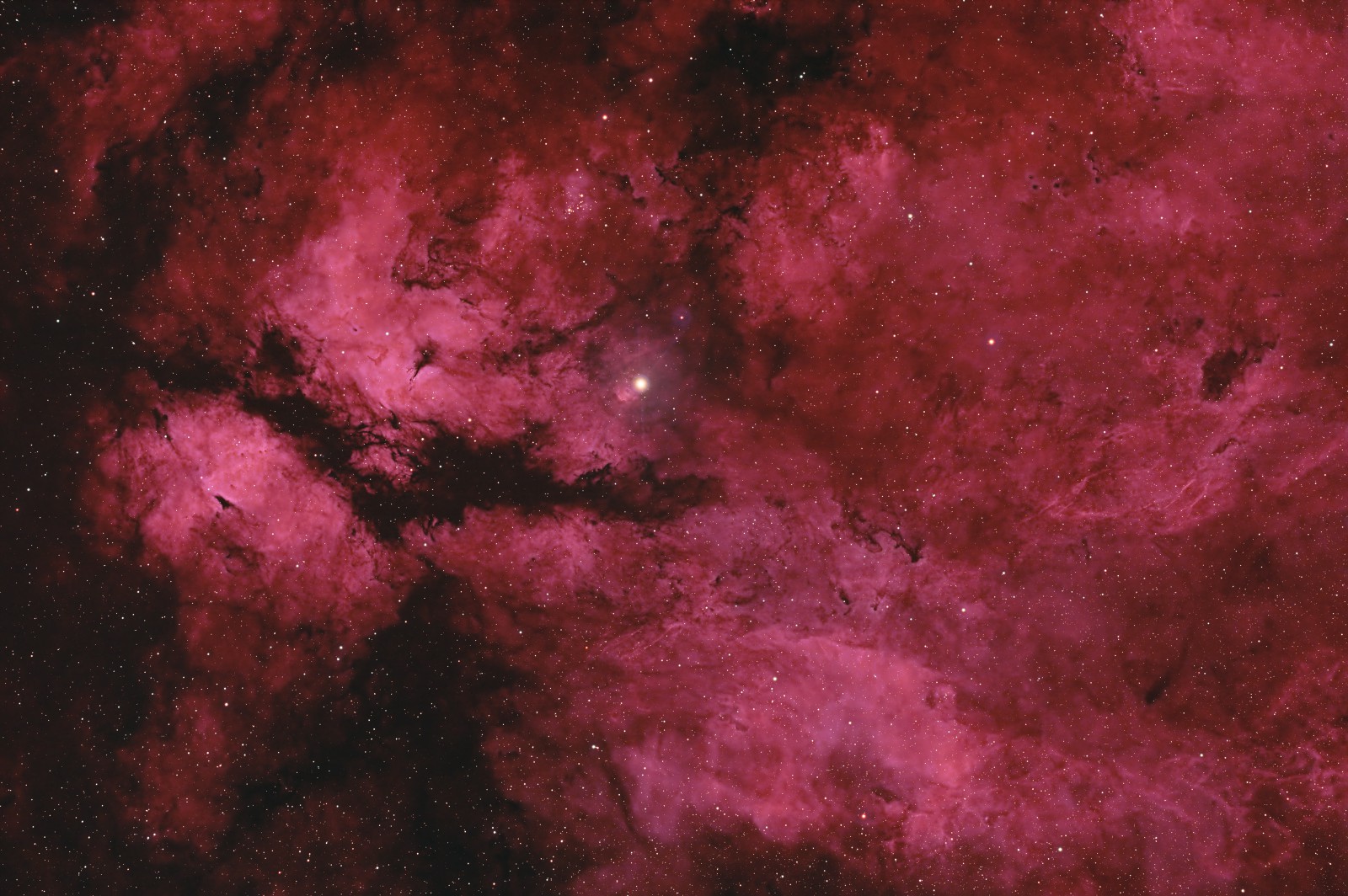IC 1318 (2022)
Click here for full size image
December 6, 2022
IC1318 is the nebula around the bright star gamma-Cygni, which is the star where the body and wings of Cygnus, the swan, cross in the sky. Cygnus is up very high in the sky in the summer and fall. Despite its appearance in this image, this nebula is actually faint and tenuous visually — the brightest parts are visible in a dark sky with a big telescope, but they look just like a faint haze in the eyepiece. The brightness of gamma-Cygni makes it challenging to see faint objects unless you keep the bright star out of the eyepiece field of view.
 The colour image above was made using a special filter for one-shot colour cameras. The filter passes only to narrow bands of light, corresponding to hydrogen and oxygen emissions. This object is dominated by hydrogen. The black and white image at right shows the H-alpha alone from a previous image of this region; click on the image to see it full size. The eye is better at picking out detail in black and white images than colour images. The colour and mono versions complement each other, and I hope you enjoy them both.
The colour image above was made using a special filter for one-shot colour cameras. The filter passes only to narrow bands of light, corresponding to hydrogen and oxygen emissions. This object is dominated by hydrogen. The black and white image at right shows the H-alpha alone from a previous image of this region; click on the image to see it full size. The eye is better at picking out detail in black and white images than colour images. The colour and mono versions complement each other, and I hope you enjoy them both.
Tekkies:
Acquisition, focusing, and control of Paramount MX mount with N.I.N.A., and TheSkyX. Focus with Optec DirectSync motors and controller. Equipment control with PrimaLuce Labs Eagle 4 Pro computer. All pre-processing and processing in PixInsight. Acquired from my SkyShed in Guelph. Very good transparency and average seeing. Acquired August 2-3, 2022, under a moonless sky.
Tak FSQ-106 @ f/5 (530mm), QHY-367C Pro One-shot colour with Optolong L-Ultimate filter
Image scale 1.9 arcsec per pixel
The WeightedBatchPreProcessing script was used to perform calibration, cosmetic correction, weighting, registration, local normalization, integration and Drizzle integration of all frames.
DynamicBackgroundExtraction was applied to the master.
SpectrophotometricColorCalibration was used to colour-calibrate the master.
The lightness coefficients of the luminance were equalized with RGBWorkingSpace, and the Luminance channel of the image was extracted for separate processing.
Colour
Linear Noise Reduction: NoiseXterminator was used to reduce noise in the background areas with settings Amount=0.9 and Detail=0
Stretching: HistogramTransformation was applied to make a pleasing yet bright image.
Luminance
Preparation of Custom PSF for deconvolution: The PSFImage script was used to create a custom PSF for deconvolution
Star Removal: StarXterminator was used to remove the stars prior to deconvolution.
Deconvolution: A stretched clone of the Lum image was used to make a mask selecting bright regions of the nebula for deconvolution. Deconvolution was applied (7 iterations, regularized van Cittert, ExternalPSF mode; Global dark deringing = 0.0008; Global bright deringing 0.0002).
Star Restoration: Stars removed using StarXterminator were added back into the image using straight addition in PixelMath.
Linear Noise Reduction: NoiseXterminator was used to reduce noise in the background areas with settings Amount=0.9 and Detail=0
Stretching: HistogramTransformation was applied to make a pleasing yet bright image.
Combining Luminance and Colour Images
Luminance addition: LRGBCombination was applied to replace the lightness of the RGB image with the Luminance master.
Additional Processing
Star Removal: StarXterminator was used to remove the stars.
Nonlinear Noise Reduction: NoiseXterminator was used to reduce noise in the background areas of the image with settings Amount=0.9 and Detail=0.25
Contrast Enhancement: LocalHistogramEqualization was applied using an inverted lightness mask to protect the background and select the nebula. Two passes were applied, each with 1 iteration at max contrast of 1.5 (scale 50, strength 0.25; and scale 150, strength 0.3).
Sharpening: MultiscaleMedianTransform was used to sharpen Layers 1 – 5 with strengths of 0.03, 0.05, 0.05, 0.04, and 0.03, respectively.
Star Shrinking: The stars-only image was cloned to make a mask. MorphologicalTransformation was used in Dilation mode to increase the size of the stars in the mask. The mask was applied to the stars-only image and MorphologicalTransformation was used in Morphological Selection mode to shrink the stars slightly.
Star Restoration: Stars removed using StarXterminator were added back into the image using straight addition in PixelMath.
Final Steps: Background, nebula and star brightness, contrast, hue, and saturation were adjusted in several iterations using CurvesTransformation with masks as required. ICCProfileTransformation (sRGB IEC61966-2.1; Relative Colorimetric with black point compensation) was applied prior to saving as a jpg.








Beautiful pic
Gorgeous image, like always!
> Deconvolution was applied (7 iterations, regularized van Cittert, ExternalPSF mode; Global dark deringing = 0.0008; Global bright deringing 0.0002)
Any reason for using van cittert instead of the usual Richardson lucy ?
It worked better.